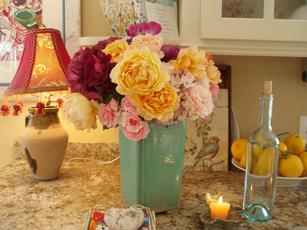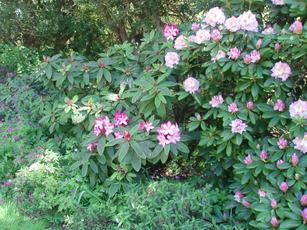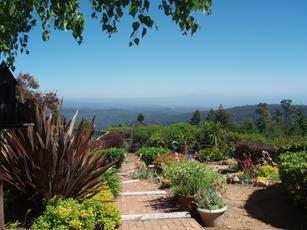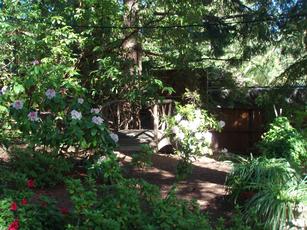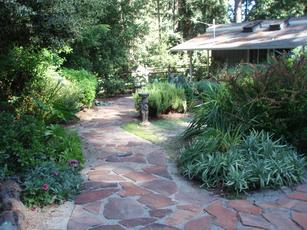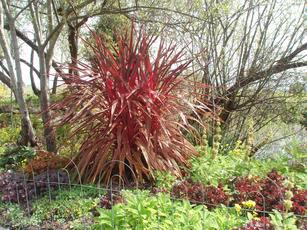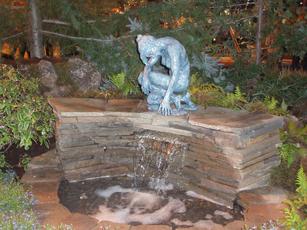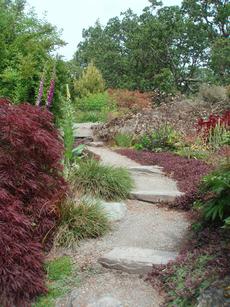 How many beautiful gardens can one visit on one vacation? I spent a whole day at the spectacular Butchart Gardens on Vancouver Island. a couple of hours at St. Ann's Academy heritage garden and the lovely Empress Hotel rose garden is a nice place to watch the sunset over the harbor. But I wanted more and on the outskirts of Victoria in a residential neighborhood I found the perfect garden.
How many beautiful gardens can one visit on one vacation? I spent a whole day at the spectacular Butchart Gardens on Vancouver Island. a couple of hours at St. Ann's Academy heritage garden and the lovely Empress Hotel rose garden is a nice place to watch the sunset over the harbor. But I wanted more and on the outskirts of Victoria in a residential neighborhood I found the perfect garden.
Smaller and more intimate, Abkhazi Garden offers a fine example of what you can do with a large lot full of rocks and trees if you put your mind to it. Now owned by The Land Conservancy of British Columbia, the property was bought in 1946 by Peggy Pemberton Carter who recognized the possibilities on this last undeveloped lot in the neighborhood. This independent minded woman traveled to the west coast after WW II from a prisoner of war camp in Georgia, using funds she had hidden during the war in talcum powder. She married Prince Abkhazi, a Russian fellow prisoner, when he joined her in Victoria and they began to build the summer house and lay out the garden together.
Over the next 40 years, Prince and Princess Abkhazi designed, planted and maintained the property. Peggy had lived in Shanghai before the war and it was this influence that plays out in the garden. Chinese gardens are essentially places of meditation, places to withdraw from worldly cares. This must have been very appealing to the Abkhazi's after their experiences in prisoner of war camps. Nothing in a Chinese garden is hurried or blatant. Paths are not just a way of getting from one point to another, instead they are a way of exploring changing views that slowly shift as you walk through the garden.
As I made my way between massive glaciated rock outcroppings and under mature native Garry oak trees gorgeous views of the snow-covered Olympic mountains and the Straight of San Juan de Fuca could be seen.
Each garden "room" utilizes the natural lay of the land and has a welcoming bench for sitting and taking in the flowers. Lots of birds and butterflies were busy feeding and going about their daily activities.
Purple allium flowers the size of grapefruit caught my attention. Growing nearby, pale yellow 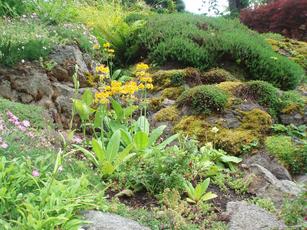 Candelabra primula[/caption]Japanese iris bordered one of the paths. Fragrant dianthus, several varieties of campanula and euphorbia, lady's mantle and candelabra primula were all blooming and the weeping Crimson Queen Japanese maples were pruned to perfection.
Candelabra primula[/caption]Japanese iris bordered one of the paths. Fragrant dianthus, several varieties of campanula and euphorbia, lady's mantle and candelabra primula were all blooming and the weeping Crimson Queen Japanese maples were pruned to perfection.
More than just a collection of plants, this garden flows with the natural contours and blends the house with it's surroundings. it is a stunning example of West Coast design. The garden flows around the rock outcroppings, taking advantage of deeper pockets of soil for conifers, Japanese maples and rhododendrons. The original Lily-of-the-Valley beds still carpet a slope. Alpine plants are placed like little jewels around the boulders and woodland plants border the undulating lawns.
A small waterfall flows into a pond where 2 large turtles sunned themselves on the rock edge while a third rested on a waterlily pad, it's red ear markings picking up the dark pink color of the waterlily flower. A stand of stately white calla lilies emerged through a piece of drifwood near a resting spot. The garden is magical. One that you could imagine on your own property if you had the next 40 years to plant and maintain it.
It would have been a terrible loss if the property had not been purchased in 2000 by The Land Conservancy. After the death of the Abkhazis the land was slated to become a townhouse development. This unique garden
is truly a place of wonder. a place to meditate and to withdraw from worldly cares.

